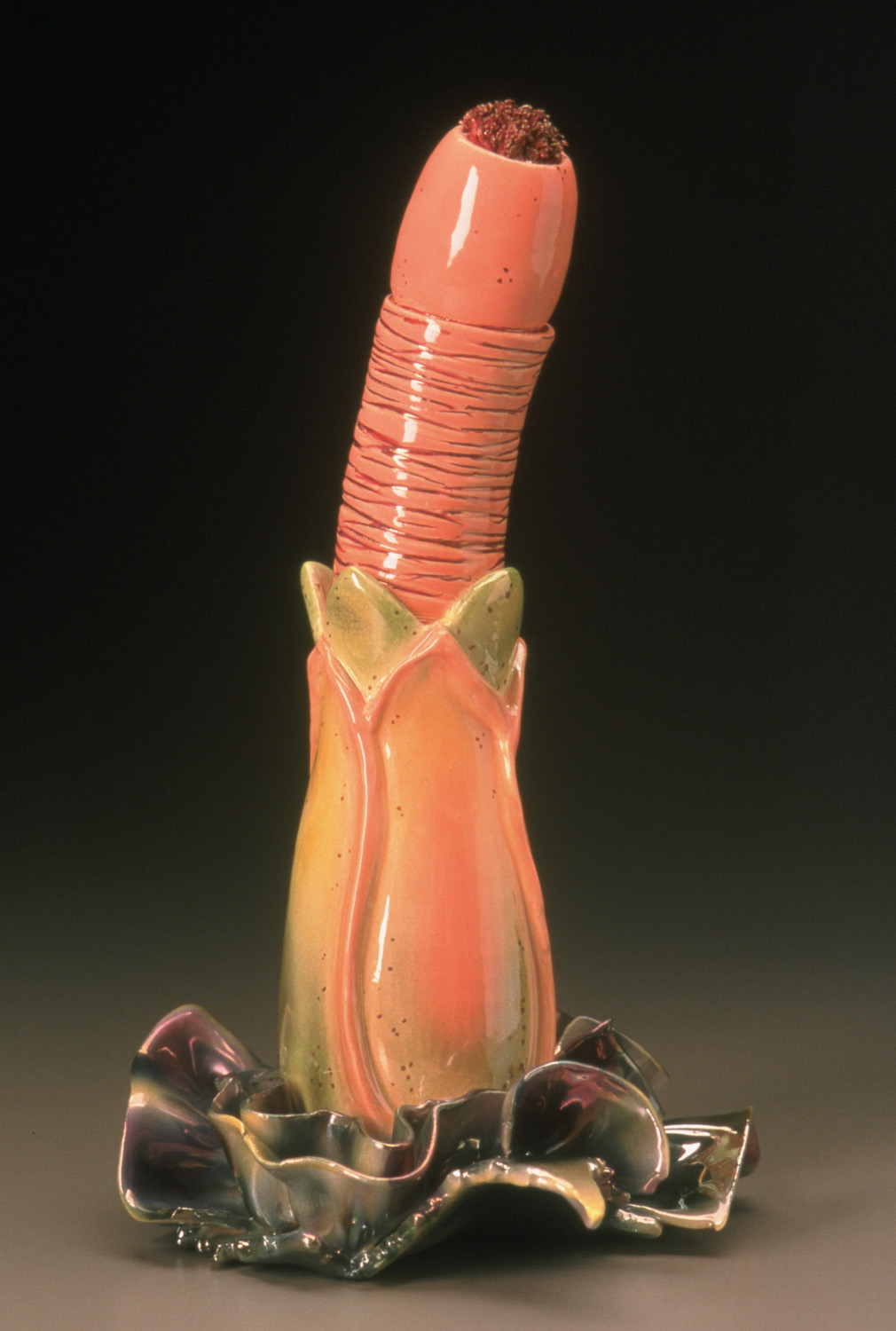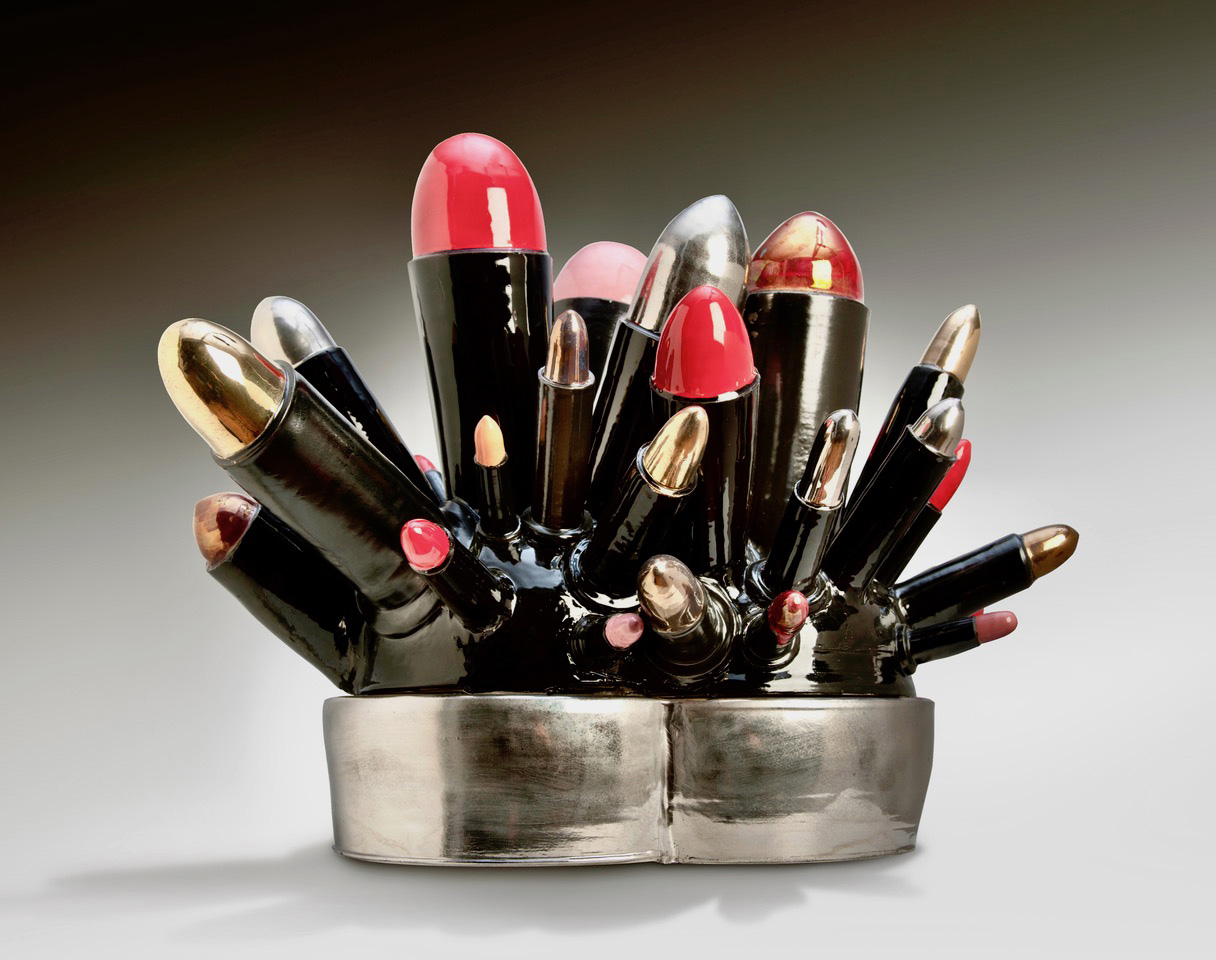With their blend of surreal retro glamor, sociopolitical and personal commentary, Linda Lighton’s ceramic sculptures command a double take. This veteran artist can make clay do just about anything, and her art has unabashed palpable appeal. But Lighton is also fearless when combining the sensuousness of her materials with controversial subject matter, whether she’s taking aim at environmental pollution, gun violence or sexism. She’s also quite comfortable creating fantastical creatures that exemplify gender fluidity.
There’s a reason one of her first solo shows at L’Omega Gallery in Kansas City in the 1980s was titled “Psycho-Ceramics.” “My art might make some people uncomfortable,” Lighton says, “but I don’t care.” Her consummate artistry, along with her sharp wit, is what makes the medicine easy to swallow.
Lighton was an activist even in her teens. She grew up in the mansion featured in the movie Mr. and Mrs. Bridge, and was expected to make her debut at the prestigious Jewel Ball held yearly at the Nelson-Atkins Museum of Art in Kansas City. (The ball was begun by her grandmother to ensure that Jews in Kansas City would gain greater acceptance into society.) She refused to go. Instead, she left home at age 19 to move to Lawrence, Kansas, got married and published a left-leaning newspaper called The Screw: A Twisting Device for Holding Things Together.

Pinky, the Tubacious Tubeworm, 2003; clay, glaze, china paint, lustres, 8 x 16 x 8.5 inches.
This caused her father, a successful department store owner and horse breeder, to have her committed to a mental institution. After taking legal action to obtain her release, Lighton moved with her husband to San Francisco, then to Seattle, to Arroyo Seco, then back to Seattle. She had a child in 1969 and was divorced in 1971. Before her divorce she moved to a private section of the Colville Reservation of the Indigenous Nez Percé people in eastern Washington state where she built an eight-sided tree house and lived with her young daughter and a friend.
“I decided I would live my life like a work of art. We had sheep, horses, I made my own soap. We were hungry a lot, and it was cold,” Lighton recalls. She took her daughter to the bus stop on a horse. “I just didn’t want my father to find me.”
Lighton met her second and current husband in Idaho, and together they built the ultimate country home that was featured in Shelter magazines. But eventually, with her husband and daughter, she moved back to Kansas City so her daughter could attend a good school.
Throughout her peripatetic early days, Lighton always found a way to study and make ceramics. “I wanted to make good art; not dishes,” she said. And after years of being restrained by her family, she remarked,“I also wanted to reveal myself. I had been brought up to be understated, to not talk and not to show myself. But I believe it’s an artist’s job to reflect what’s going in the world—and it’s also how we learn about ourselves.”

The Kiss, 2004; clay, glaze, china paint, lustres,12 x 9.5 x 9.25 inches.
Lighton attended the Factory of Visual Arts in Seattle from 1971–74, where she studied ceramics with such greats as Patty Warashina, Ann Currier and David Furman. She also studied painting and ceramics at the University of Idaho from ‘76–’78, and when back in Missouri, received a BFA from the Kansas City Art Institute in 1989. By then she had already exhibited her art extensively.
The theme of metamorphosis, one of Surrealism’s most prevalent topics, is often present in Lighton’s art. In the early ’80s she created a series of sculptures composed of houses with people’s heads and other body parts attached. Over the years, in various series she calls “Trash,” Lighton created groupings of objects which at first glance resemble precious objects, but actually were anything but. In 1983 she fabricated “White Trash,” a clustering of gorgeous white porcelain ceramics formed, on closer viewing, to resemble discarded plastic dishes, egg cartons, etc.—her commentary on first-world littering. In 2018, her “Trump Trash” series consisted of porcelain water bottles, guns, bullets and broken gas nozzles covered in gold metal leaf, neatly illustration right-wing cultural motifs.

Chandelier, 2020; porcelain, silk cord; 66 x 54 x 48 inches.
Her “Divas,” from the 1990s and 2000s, celebrated women of accomplishment in the form of blossoming, flamboyant clusters of vibrantly colored flower bulbs and leaves. They are somewhat egg-shaped, in the process of morphing into something unknown, and undeniably dynamic. The “Divas” were an outgrowth of Lighton’s ongoing series of fantastical over-scaled flowers that both dazzle and intimidate. As Lighton states, “They mean to say: Choose me!”
This relates to one of Lighton’s most deeply felt themes, that of desire (in 2015 she curated an international exhibition of ceramics titled “Desire,” and published a major catalog of the show). “I believe that what keeps us going is desire,” she says. “Much of what is beautiful in nature is also ostentatious,” Lighton notes, “and exists to attract others of its kind. Without sex, obviously, everything would cease to exist.”
When it comes to weaponry Lighton is a knowledgeable, statistic-laden anti-gun lobbyist. For more than 10 years her ceramics, such as I don’t want a bullet to cross your heart from 2012, not only deal with gun violence in America; they force the viewer to take a hard look at the dark side of desire in this country. Her pristine, off-white copies of every kind of gun available in America—made from casts of real pistols and rifles, precariously stacked in mountainous peaks—underscore the availability of weaponry here while simultaneously stressing the fragility of life itself.

Love and War: The Ammunition, 2011; clay, glaze, china paint, lustres, 16 x 22 x 19 inches.
An outspoken feminist, Lighton also pulls no punches about women using sex as a form of ammunition. In “Love and War” from 2011, lipstick tubes and bullets are virtually inseparable from one another, both forms of powerful artillery. The same concept is beautifully articulated in Thoughts and Prayers, which also includes guns. Lighton is known for her refined use of lustre paint, and nowhere is this more apparent than in her siren-like lipsticks and bullets.
Lighton increasingly collaborates with other artists, musicians and poets. In her 2010 installation “Luminous” she created a site-specific environment with ambient sound and light effects, encouraging viewers to deal with “the fragility of life, the beginning of the last chapter.” She wanted participants to “be transported to a contemplative and dreamy place to escape the mundane and consider the ethereal and ephemeral.” The Kansas City Museum just added a chandelier from this series to its newly refurbished building.
Lighton is currently working on a large-scale ceramic wall for the new Kansas City airport, still under construction. On it she is painting dozens of branches with indigenous birds perched throughout. It is a different kind of tree house, one in which all the inhabitants are free to come and go.
“Nothing I do can be made in less than three months,” Lighton says. “So I really have to decide I want to make it before I start.”



















Love it, Linda!
We were ex-patriating from KC in Seattle at the same time. Irv Tepper (I guess you knew Irv)was my neighbor. I worked for KOL-FM.
I remember Don Maxwell showing me and my daughter Katie clips from his film about you and your work regarding guns.
I look forward to seeing your new work in the new airport.